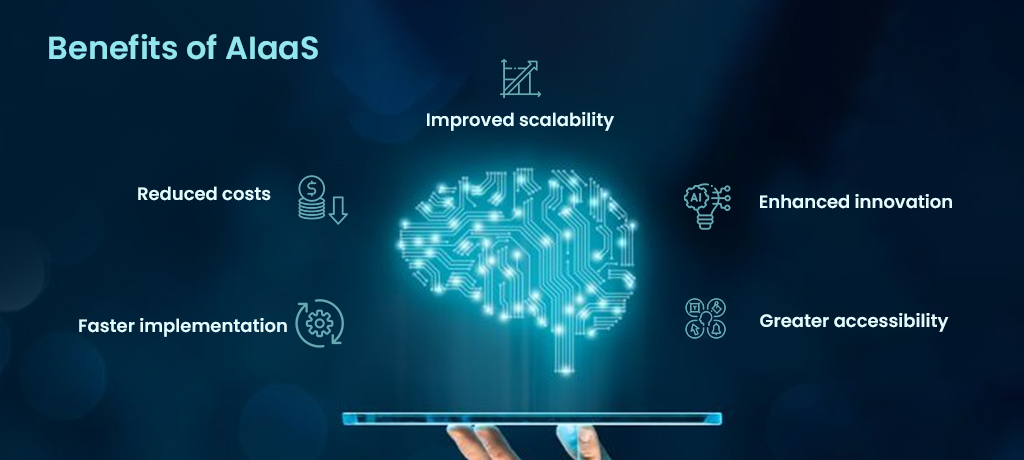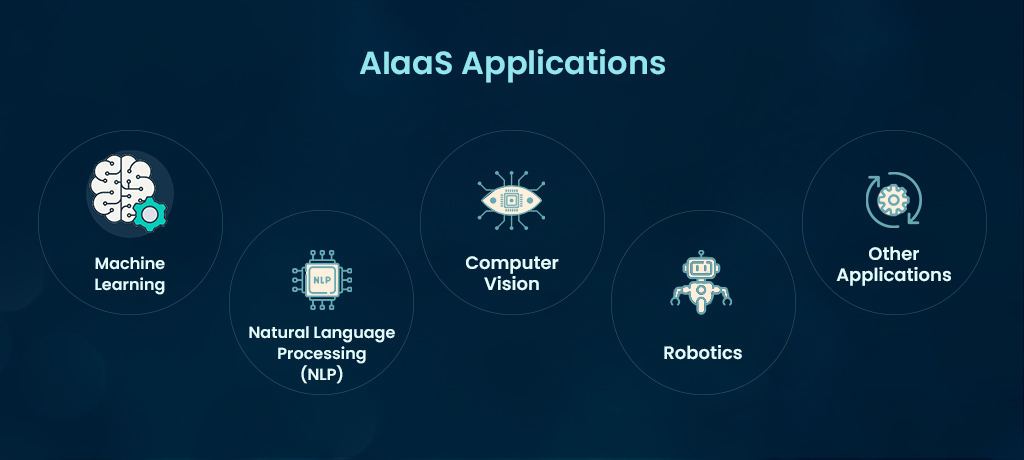Table of Contents
The advent of Artificial Intelligence (AI) has transformed the way businesses operate. Today, AI is increasingly becoming a critical part of business operations, and its adoption has grown exponentially in recent years. One of the emerging trends in the AI industry is AI as a Service (AIaaS), which offers businesses the opportunity to leverage AI capabilities without investing in expensive hardware and software infrastructure. Consult with the top artificial intelligence solution companies to get more idea on AI as a service .
What is AIaaS?
AIaaS refers to Artificial Intelligence as a Service and it means providing AI capabilities as ready-to-use services over the internet. AIaaS companies and providers offer AI services and solutions through their cloud platforms.
Some top AIaaS solution companies are Google, Amazon, Microsoft, IBM and Cisco. These companies provide AI services such as machine learning, natural language processing, computer vision, chatbots, and predictive analytics. Users can leverage these services through simple APIs and integration with their applications.
Need for AiaaS
AIaaS helps organizations quickly adopt AI technologies without setting up their own AI infrastructure. Customers only pay for the services they use, offering more flexibility and cost-effectiveness. AIaaS facilitates collaboration as different teams can work together on a shared AI platform.
Integration of new AI functionalities is faster and more seamlessly. AIaaS Providers constantly upgrade their services with the latest AI advancements and algorithms. It ensures that AI solutions remain innovative and relevant.
Features and Characteristics of AIaaS
AIaaS companies and top providers offer AI services with certain key features and benefits. These include flexibility, scalability, simplicity, cost-effectiveness, and innovation.
- Flexibility: AIaaS provides flexibility as customers can start or stop using services anytime based on their needs and budget. New AI features can also be integrated seamlessly. Users have the flexibility to choose only the services they need.
- Scalability: AIaaS allows for easy scaling of AI solutions by adding or removing services and associated computing resources. It ensures that AI systems have enough capacity to process large volumes of data and handle increasing workloads.
- Simplicity: AIaaS hides the complexity of AI technologies from users. No specialized skills are required to deploy or manage AI solutions. Simple APIs and interfaces are provided to integrate services into applications. This simplicity makes AI accessible to non-technical users as well.
- Cost-effectiveness: AIaaS follows a pay-as-you-go model where customers only pay for the services they use. There are no large upfront licenses or infrastructure costs. Costs can also be optimized by scaling services up or down as needed. It makes AI more budget-friendly and affordable.
- Innovation: Top AIaaS companies continuously enhance their services with new AI algorithms, technologies and features. Customers always have access to the latest AI advancements through regular updates. It helps ensure that AI solutions stay innovative and cutting-edge.
AIaaS satisfies key flexibility, scalability, simplicity, cost optimization and innovation requirements, which fuels broader AI adoption. It simplifies and democratizes the use of AI, bringing more intelligence into businesses worldwide. AIaaS thus enables an AI-powered future with immense possibilities.
Top Benefits of AIaaS

AIaaS or Artificial Intelligence as a Service, offers several benefits to organizations. Some key benefits are faster implementation, reduced costs, improved scalability, enhanced innovation and greater accessibility. These benefits are explained in detail as follows-
- Faster implementation: AIaaS allows for quicker deployment of AI solutions. There is no need to set up infrastructure or hire specialized skills, saving time and effort. AI services can be integrated with applications in weeks using simple APIs. This faster time to market helps businesses gain a competitive advantage.
- Reduced costs: AIaaS follows an operational expenditure or Opex model with no significant upfront investments. Customers only pay for their services, offering more flexibility and affordable costs. No budget is required to purchase licenses, set up hardware or pay for IT resources to manage AI infrastructure. Overall Total Cost of Ownership is lower with AIaaS.
- Improved scalability: It is easy to scale AI solutions up or down as needed through AIaaS based on changing requirements and workloads. Additional services can be provisioned within minutes to handle growing data volumes and more complex analyses. Under-utilized services can also be scaled down to optimize costs. It provides more flexibility and responsiveness.
- Enhanced innovation: Top AIaaS companies continue advancing their services with cutting-edge AI technologies and new features. Customers always have access to the latest innovations and new capabilities through automatic updates. AI solutions can be upgraded seamlessly to improve performance, add new functions and enable innovative use cases.
- Greater accessibility: AIaaS democratizes AI and makes it more mainstream. With simple interfaces and APIs, technical and non-technical teams can leverage AI for various needs. There are no barriers to entry in terms of skills, investments or infrastructure. Many AI tools and services are available for different industries, use cases and skill levels. This broad access helps achieve more excellent value from AI across the organization.
AIaaS Applications

AIaaS providers and top solution companies offer various artificial intelligence services and features. These include machine learning, natural language processing, computer vision, robotics and other applications.
Machine Learning
Machine learning algorithms and models can be deployed through AIaaS to learn from data and make predictions. Customers can build supervised learning models, unsupervised clustering models or reinforcement learning agents. Scalable machine learning APIs and frameworks are available for classification, regression, recommendation systems, forecasting and anomaly detection.
Natural Language Processing (NLP)
NLP services on AIaaS enable the processing and understanding of human language. APIs and tools are provided for text classification, sentiment analysis, machine translation, summarization, question-answering systems, chatbots, topic modelling and more. NLP transforms how businesses interact with customers and utilize information.
Computer Vision
AIaaS computer vision services enable extracting insights from images, videos and sensor data. Object recognition, facial recognition, scene understanding, action recognition, 3D vision and robotic vision APIs are useful. These help with visual search, tagging, classification, tracking, semantic segmentation, scene text OCR and automation. Computer vision enhances surveillance, inspection, recommendation systems, healthcare, e-commerce, etc.
Robotics
Robotic process automation tools and APIs on AIaaS allow the automation of repetitive tasks like data entry, customer service, material movement, inspections etc. Software bots can perceive the environment, navigate autonomous mobile robots, manipulate robot arms, assemble products and collaborate with humans. Integrating robotics improves efficiency, reduces errors, frees up employees for higher-value work and increases production.
Other Applications
Additional AI services include analytics, planning, natural language generation, conversational AI, knowledge graphs, reinforcement learning, meta-learning, unsupervised learning, federated learning, one-shot learning, continual learning, domain adaptation, transfer learning, adversarial learning, privacy-preserving machine learning and more.
AIaaS Business Models
Artificial intelligence solutions and top Artificial intelligence companies in USA offer their services through different business models. It includes pay-as-you-go, subscription-based, freemium, and other models.
Pay-As-You-Go
Customers pay for the AI services they use on demand in the pay-as-you-go model. There are no long-term contracts or commitments. Payments are made based on actual consumption of services and resources. It offers flexibility and cost efficiency as spending can be controlled easily. However, pricing may be higher per unit and planning ability is limited. Most AIaaS providers follow this model.
Subscription-Based
Customers pay a periodic fee for unlimited or fixed quantity access to AI services with a subscription. Commitments are typically annual contracts with penalties for early termination. It provides predictable revenue, planning flexibility, and potential volume discounts for AIaaS providers and businesses. However, costs are fixed even if some services are underutilized.
Freemium
In the freemium model, some AI services are offered free, while premium paid services provide additional features or higher limits. The goal is to convert free users into paying customers over time. It works well for AIaaS, where core features can be freely available to demonstrate value. However, not all free users may choose to upgrade to paid plans. Retention of free users and conversion into long-term paying customers is critical.
Others:
A few AI companies also follow business models like:
- Custom AI Solutions: Developing customized AI systems and solutions for enterprise clients on demand. High upfront costs but meets unique needs.
- Partnerships: It involves partnering with other businesses to embed AI applications within their products and services. Revenue share models are standard. Expands reach but reduces control and margins.
- Licensing: It provides licenses to use owned AI software and tools. One-time or ongoing licensing fees are charged from clients who deploy licenses internally. Limited customization is possible for different needs.
- Hybrid: Combining multiple models like pay-as-you-go services, licensed software, or premium subscription offerings with freemium features. It diversifies revenue streams and fits varied customer requirements.
In conclusion, AIaaS companies have evolved different pricing models to make AI more accessible and affordable for all businesses. While pay-as-you-go and subscriptions are mainstream, other innovative models are also gaining traction. An optimal model depends on the customer base, services portfolio, growth plans, resources and margins. AI solution providers can benefit by analyzing different models and implementing a hybrid approach that maximizes opportunities while balancing risks. With continual innovation, more options will emerge in the AIaaS market.
AIaaS Deployment Models
AI solution companies and top AI firms in the US offer their services through different deployment models, including cloud-based, on-premises, hybrid and others.
Cloud-Based:
The cloud-based model hosts AI services and platforms on the provider’s infrastructure. Customers access everything through internet connectivity and APIs. It eliminates the need to maintain hardware and software on-premises. Key benefits are low, upfront costs, flexibility, automatic updates and scalability. However, some organizations face restrictions on customization, control, latency issues or internet dependency. Most AIaaS providers follow a cloud-based deployment.
On-Premises:
In the on-premises model, AI solutions are installed and run on infrastructure within the customer’s organization. The specific AI software and platforms are deployed on the customer’s servers and data centres. Complete control, customization and integration with existing systems are possible. However, higher upfront licensing and deployment costs, limited scalability and slower innovation adoption tend to be issued. Some AI vendors still offer on-premises installation options for larger enterprises with specialized needs.
Hybrid:
Some AI companies support a hybrid model with deployments on-premises and cloud. Specific components or workloads run on-premises while others operate on the cloud platform. Hybrid approaches aim to achieve the benefits of both models and mitigate their limitations. Complex integration is required to ensure seamless data, application and workflow connectivity across the hybrid infrastructure. Management and optimization also become more challenging. But hybrid AI deployments are gaining popularity, especially for migrating existing on-premises solutions to the cloud.
Others:
Other lesser standard AI deployment models include:
- Edge Computing: Deploying AI technologies close to data sources at the network edge. Enables localized processing, lower latency, and disconnect independence. But higher upfront costs, limited resources and skill requirements increase at edge locations.
- Multi-Cloud: Running AI workloads on multiple cloud platforms to avoid vendor lock-in and achieve greater choice, resilience and innovation. However, expensive to set up and manage, there are integration challenges and no ‘one-stop’ solution.
- Federated Learning: Pushing computation to distributed client devices and aggregating collective model updates in a central server. Suitable for healthcare, finance and other sensitive industries. But complex to implement and coordinate compromises overall efficiency and generalizability.
AIaaS Challenges
While AIaaS promises many benefits, specific challenges are associated with adopting AI technologies through service-based models. Some of these challenges are as follows-
Security and Governance:
When data and algorithms run on third-party Cloud platforms, ensuring security, privacy, access control and regulatory compliance becomes critical. It requires strong governance frameworks, enhanced visibility and accountability across interfaces. Stricter policies may be needed to prevent unauthorized access, exposure of sensitive information, legal issues or brand damage. Governance costs also tend to increase with AIaaS.
Integration Complexity:
Integrating AI services with existing systems and workflows can be complex, time-consuming and expensive. Multiple interfaces, APIs, formats, protocols, and schemas must be mapped, reconciled and connected seamlessly. It includes integrating data sources, applications, databases, ERP systems, and more. Tight integration is important but challenging to achieve in practice and can hamper time-to-value.
Vendor Lock-In:
Relying on select AIaaS providers for access to services and knowledge resources introduces the risk of vendor lock-in. Once deeply invested in a particular platform, transitioning to alternatives can be difficult, costly and disruptive to operations. It limits choices and flexibility. Lock-in also reduces negotiation power over terms, features, pricing, platform upgrades and data ownership. Providers can exploit their position in the market.
Skills Gap:
While AIaaS aims to make AI more accessible, developing and managing AI solutions requires specific skills. Specialized skills may be needed around AI engineering, machine learning, model deployment, data science, integration and governance best practices etc. Not all organizations would have these skills in-house, compelling them to rely on expensive external consultants and services. It highlights the need for building internal talent and AI literacy.
Bottom line
In summary, AIaaS offers a pragmatic path to adopting AI and unlocking its potential benefits. However, significant challenges remain around security, integration complexity, vendor lock-in and skills gap. Companies must address these to realize the true promise of AIaaS. Governance frameworks, partnership models, open standards, talent development programs and other innovative approaches can help mitigate risks and maximize returns from AIaaS. With proactive management of key challenges, AIaaS has the potential to accelerate AI-led digital transformation at scale across industries.
Unleash the potential of AIaaS and gain a competitive advantage
AIaaS Future Trends
AI and AIaaS continue advancing rapidly, introducing exciting new possibilities while raising important questions about how these technologies will shape the future. Exploring potential innovations and critical trends in AIaaS helps organizations prepare for what is to come.
Advancements in AI Technologies
AI continues advancing rapidly in machine learning, deep learning, reinforcement learning, transfer learning, federated learning, generative models, meta-learning and more. Integrating AI with physics, healthcare, finance, law, etc., will open up more possibilities. AIaaS providers will keep enhancing their services with the latest AI algorithms, features and platforms to maintain competitiveness.
Integration with Other Technologies
AI will integrate deeply with technologies such as blockchain, cloud computing, cybersecurity, edge computing, IoT, computer vision, NLP etc. Blockchain-enhanced AI can provide trusted, transparent and verifiable AI systems. Integrated AI-Cloud solutions will emerge for streamlined management across infrastructure and software stacks. The tight coupling of AI with IoT and edge analytics will enable context-aware intelligent systems. More hybrid approaches combining multiple technologies will also develop.
AIaaS for Edge Computing
With increasing data generation at network edges, AIaaS is likely to expand to edge computing environments. Providers will offer dedicated edge AI platforms, services and tools to build and run AI applications locally. Key benefits include lower latency responses, reduced bandwidth requirements, offline computing capabilities and suitable data governance. However, resource constraints at the edges may limit advanced AI. Management across centralized cloud platforms and distributed edge networks could also prove challenging.
Emerging AIaaS Business Models:
Some potential new business models include:
- B2B2X: Providing AIaaS to other B2B companies that embed intelligence into products, services and platforms for their B2C customers. Revenue-sharing models may apply.
- Freemium Enterprise: Offering specialized freemium and premium plans for large enterprises with different service levels, features and pricing based on company size, industry, geography etc.
- AIaaS Marketplace: Building an open AI service marketplace that brings together suppliers (AI providers), demand aggregators (AI-based companies) and consumers (companies purchasing AI services and capabilities). Generation of revenue is from service fees, subscriptions or deals which are there on the platform.
- AIaaS Licensing: Providing licensed access to self-service AI platforms, frameworks, tools and datasets required to build customized AI solutions. Volume-based pricing and SLAs ensure governance and quality.
- Freemium for Good: Targeting social enterprises, NGOs, startups and research organizations with a freemium AIaaS model focused on sound.
Ethical and Social Considerations
As AI becomes more sophisticated and integrated through AIaaS, ethical and social issues simultaneously emerge that must be addressed to maximize the benefits of AI and ensure its responsible development.
AI Bias and Fairness
AI models trained on limited data or designed by predominantly homogeneous teams can reflect and even amplify unfair biases. It poses significant risks with AIaaS, where multiple stakeholders contribute to developing applications and algorithms. Establishing accountability, conducting audits, encouraging diversity and implementing controls are in need to build equitable and unbiased AI solutions at scale. But governance challenges exist in decentralized environments.
Privacy and Security
With AIaaS, data and algorithms run on third-party platforms outside customer control. It makes it difficult to implement privacy regulations, prevent unauthorized access or ensure security. Exposure , exploitation and leakage of sensitive information is easy. Strict policies, transparency requirements, robust security frameworks and accountability mechanisms have to be in place by providers to gain user trust while still maintaining a competitive advantage. But privacy concerns may limit data sharing and innovation.
Workforce Impact
While AIaaS aims to make AI more accessible and productive, its impact on human jobs could be substantial. Many routine jobs may get automated by AI services, altering whole industries and workforces. Reskilling existing employees, creating new roles, implementing safety nets and involving stakeholders early on is essential to managing disruption. However, increased efficiency and economic gains from AIaaS will likely displace some jobs and change socio-economic demographics over the long run.
Transparency and Explainability
As AI systems become increasingly complex, determining how and why they make predictions or decisions can be difficult. This ‘black-box’ problem is exacerbated with AIaaS, where multiple AI models interact and integrate. Lack of explainability undermines accountability, trust in AI decisions, identification of biases and ability to optimize systems. AIaaS providers must improve model interpretability, develop tools for explaining AI outputs, incubate approaches enhancing transparency, and incentivize developing transparent AI solutions.
Ethics
Significant ethical issues emerge with the increased capabilities, scale and dependencies associated with AIaaS. Addressing risks around bias, privacy, job impact, and lack of explainability requires a collaborative and thoughtful approach from researchers, companies and policymakers. Governance frameworks have to balance the innovation benefits of AIaaS with social responsibilities. Additionally, AIaaS can positively transform society and humankind with proactive management of risks and challenges. But neglecting considerations here could have damaging consequences, undermining public trust in AI and progress. AIaaS must aim to build fair, private, trustworthy and beneficial AI for sustainable development.
Conclusion
AIaaS has emerged as a game-changing technology that allows businesses to leverage AI capabilities without having to invest in expensive hardware and software infrastructure. The exponential growth of AIaaS has opened up opportunities for businesses to tap into the vast potential of AI and gain a competitive advantage. However, as with any emerging technology, some challenges emerge such as ethical and social considerations, legal and regulatory challenges, and technical challenges. In conclusion, AIaaS offers immense potential, and businesses that adopt it will likely reap significant future benefits.
Frequently Asked Questions (FAQs)
What is an AI service?
An AI service refers to providing AI capabilities as tools and APIs over the internet. Companies offer access to AI technologies through cloud-based services like machine learning APIs, natural language generation and robotics process automation bots. Users can leverage these services for automation, insights and improved processes across applications and platforms.
What are the four types of AI?
The four major types of AI are narrow, general, weak, and strong. Narrow AI has limited capabilities, general AI has human-level intelligence, weak AI refers to any tool that performs a specific, limited task, and strong AI matches human intelligence generally. With narrow and weak AI power services today, general and robust AI remains elusive.
What is the concept of AI?
Artificial Intelligence, or AI is the field of computer science which focusses on developing intelligent machines that can learn, reason, and solve problems in a human-like manner. AI systems use machine learning algorithms and huge data to perceive their environment. Also, they learn how to perform tasks, solve complex problems, perceive emotions, translate languages and more.
The overall goal of AI is to create intelligent agents and software that assist, collaborate and augment human capabilities instead of replacing them entirely. AI can radically change numerous industries and society but also poses risks around bias, privacy, job impact and lack of transparency. This requires careful management.
What are the benefits of AI as a service?
What are the benefits of AI as a service? AI as a service, or AIaaS, offers several key benefits. It provides flexibility and scalability to adapt AI solutions based on evolving needs. Costs are predictable and scalable, reducing risks. Innovation is continuous as services improve regularly. Complexity is hidden, allowing focus on core business objectives. This enables wider integration across systems through simple interfaces. Moreover, the transition from on-premises deployments is smoother. Customers pay only for what they use, optimizing spend. Overall, AIaaS makes AI more accessible, affordable and impactful for organizations.
What is the role of AI in customer service?
AI plays an important role in enhancing customer service through several applications. Chatbots handle simple queries, keeping humans focused on complex issues., while natural language generation produces personalized responses at scale. Analyses uncover insights driving improved personalization and recommendations. Automation reduces routine contacts, enabling faster resolution of high-priority matters. AI identifies at-risk customers, triggering proactive support. Bots collaborate with agents instead of replacing them.






